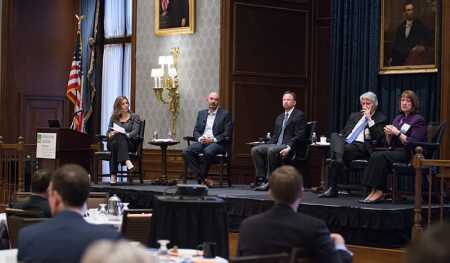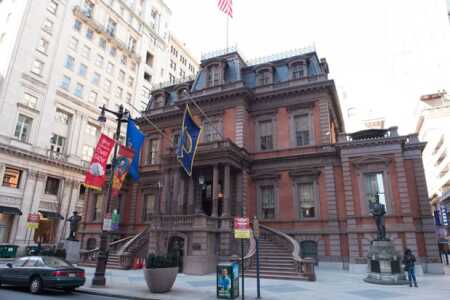For suburban developers, density used to be a dirty word, but not anymore. James Mazzarelli, senior vice president of Liberty Property Trust, told the audience at recent ULI event in Philadelphia that until recently he would instruct his development team to downplay the urban qualities of apartment proposals or walkable retail projects in pitch meetings with suburban officials.
“It’s really about using less land to generate more tax revenue and income. I think everybody’s figuring this thing out now,” Mazzarelli said on stage at the Union League in Philadelphia. “Today I’m sitting up here with a well-respected township planner who’s using the word densification.”
Mazzarelli was referring to cospeaker Terry Woodman. She had successfully pushed in favor of more transit-oriented development for her far-flung municipality in order to keep pace with changing demographic trends and consumer preferences.
Register for the Spring Meeting in Philadelphia | Spring Meeting Tours
Also on the panel was Michael Markman, president of BET Developments, and Eli Kahn, principal at E. Kahn Development Corp. Both developers are in the midst of executing dense, mixed-use projects elsewhere in a suburban region increasingly open to urban development—more evidence of shifting development philosophies locally and across the United States, where more and more outlying municipalities are turning to denser projects to lure younger residents and boost tax revenues.
Markman’s company is reimagining a dying mall in an inner-ring suburb as apartments with a walkable outdoor retail component—a revolutionary idea for a township dominated by postwar single-family housing.
“There hadn’t been new apartments approved for that township in 40 years before our project,” he said.

From left to right: moderator Leigh Gallagher, assistant managing editor at Fortune; Eli Kahn, Principal, E. Kahn Development Corp., Michael Markman, President, BET Investments; James Mazzarelli, senior vice president, Liberty Property Trust; Terry Woodman, Principal at Special Projects Consulting and former Manager of East Whiteland Township in Chester County, Penn. (Scott Spitzer Photography/ULI)
Kahn said he was bringing a similar concept, anchored by a chic Anthropologie clothing store and “mom and pop” boutiques to an exurban township best known for its suburban office parks.
Both developments were held up as evidence of shifting development philosophies locally and across the United States. Many suburban areas are aging and facing mounting infrastructure costs combined with population stagnation as younger generations, repulsed by sprawl and lengthy commutes, flow into bustling urban centers.
“You can see there’s a sense of, ‘Okay, what’s changing?’ ” Mazzarelli said of consultations with suburban officials. “I’m unsanitized. I say, ‘If you guys don’t get control of this situation, your coffers are going to run dry. You’ve got to figure out what millennials want.’ ”
Woodman said it was critical for both administrators and developers to get on the same page about the shared problems they will face in coming decades if suburban areas are going to maintain their relevance. She said that fiscal shortfalls for suburban governments or imploding real estate markets if these areas fail to adapt were not out of the question.
There was a potential for suburbs to “cash in” on the increasing desirability of walkable neighborhoods through projects that Markman characterized as “urban-lite.” But overcoming historic stigmas surrounding denser development is only one part of the solution—most lending mechanisms continue to encourage single-family housing over mixed-use projects, and resistance to expanding public transport in the suburbs could leave many townships stranded, according to Woodman.
“You have to put the density where the infrastructure is,” she said. “It’s a crisis, and ultimately suburbs are going to have to face it.”
Although the panel agreed that much of the current demand for urban-ish projects was coming from empty nesters, Mazzarelli said he was convinced it was a market that would expand as millennials started families and looked for better school options beyond cities—the so-called boomerang effect.
However, moderator Leigh Gallagher, assistant managing editor at Fortune and author of The End of the Suburbs, took questions from one skeptical audience member, concerned that wrapping traditional suburban chains in more walkable commercial developments—so far, the format that many urban-lite projects have taken—would be enough to lure younger residents away from booming cities.
Khan said that boutique stores and high-end restaurants were what his market wanted, and that he had focused on curating his development to that end. But Markman and Mazzarelli admitted that it was often a challenge to attract and keep desirable mom-and-pop stores in suburban developments.
Getting the mix “just right” is an amorphous challenge, and perhaps one of the biggest for suburbs that will likely struggle to shake of the stigma of being “unhip.”
Mazzarelli said that on vacations to Portland, Maine, he was consistently astounded by the mix of small shops and restaurants that the city maintained.
“You don’t see Starbucks, you see Maine Coffee Roasters. They don’t drink Budweiser, they drink Shipyard Ale. You don’t see Applebee’s,” he said. “Somehow, Portland has figured this out. I don’t know how; I wish I could tell you.”





